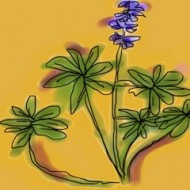The Dry Garden: Pruning sage
Last spring, horticulturist Lili Singer remarked to me that one of the most touching mistakes she sees made by novice dry gardeners is timidity in pruning their sages. And so, in the summer edition of the Theodore Payne Foundation’s Poppy Print newsletter, she nudges native gardening converts to do it.
With thanks to Lili for the push, I am going to echo the prompt in this column in the hope that others may learn to work out their frustrations on their gardens in such a timely fashion.
If it seems late, it isn’t. Only the most ferociously organized gardeners dead-head sage as soon as the flowers fade in June. Watching the flush of flowers drying on the branch through July and August makes for too many sunset grace notes. As Lili notes, birds move in and glean the seeds. Yet by late August, those fluttering elegies to spring just …
The Dry Garden: Wet policy for a dry year
Source: NOAA. Click on the maps to be taken to composite graphics of precipitation trends during La Niña years.
We’ve been getting mixed messages about whether or not we need to conserve water. On one hand, we had a decent local rain year. Last week, the state legislature pulled a water bond from the November ballot that would have driven state-wide conservation. This week, the Los Angeles City Council amended the two-day lawn sprinkler ordinance to a three-day version.
Crisis over?
Not by a long shot. Local rain doesn’t fill our pipes. Of the three main sources that do, Lake Mead, the Colorado River storage reservoir serving Southern California, shrank in July to its lowest level since 1956. Last month, the State Water Resources Control Board concluded that the Sacramento-San Joaquin Delta is overdrawn by 50%. Southern California could do its part to fix that by reducing water use from …
The Dry Garden: Vertical waste
Detail of a "Woolly Pocket" (actually recycled plastic) at the SmogShoppe vertical garden in Culver City in summer of 2010. Normally drought tolerant succulents require routine irrigation in a mouldering setting. Photo: Emily Green
They say you catch more flies with honey than vinegar, but I’ve never wanted to catch flies. Moreover, as borrowed phrases go, I far prefer, “If you don’t have anything nice to say, sit by me.” And so, I issued an invitation: If you are skeptical about the vogue for vertical gardens, sit by me.
A few smart people from the worlds of gardening and landscape architecture took the chair. Here’s what they had to say.
Click here to keep reading this week’s ‘Dry Garden’ in the Los Angeles Times.
A comment string to do with this post has been removed because it was overpopulating the home page and descending in tone. The sentiments of the …
The Dry Garden: Choosing fruit
Central to the promise of the California dream is the idea that you can reach out of your kitchen window and pluck a lemon. As we hit the limits of our water supply, that specter of home-grown fruit remains steadily possible, even a social ideal in the complex matrix of energy and water footprints.
In attaining it, the first hurdle is choice: What kind of lemon? What about oranges and limes? A modest lot in Los Angeles can produce full loads of not only citrus but also avocadoes, plums, apricots and nectarines. And don’t forget figs, pomegranates and apples. A long list only becomes longer when you consider the varieties and crosses available for each type of fruit. Valencia orange or blood? Eureka lemon or Meyer? Plum or “aprium”?
Choice of fruit trees is one of the most important decisions that you’ll make in a garden. You’ll be eating the …
The Dry Garden: Past as prologue
The West Adams Heritage Assn. celebrates the preservation of historic houses, but earlier this month, a markedly modern installation in Jefferson Park shared its “best garden” prize. Look at the home of Marina Moevs and Steve Peckman, and it’s obvious why: Few gardens could do a better job accenting but not overwhelming their lovingly restored Craftsman home.
After having taken pains to strip, then stain the clapboard for a weathered, muted effect, the first criterion that Moevs and Peckman put to a local garden designer was to keep the plants low. Herbs would be welcome, but they didn’t want any specimens taller than 3 feet. Furthermore, they didn’t want to water — or at least water often. Finally, they wanted to capitalize on a cash-for-grass program that offers rebates for replacing turf with a low-water alternative.
Click here to keep reading about the Peckman-Moevs project in The Dry Garden in …
« go back — keep looking »

